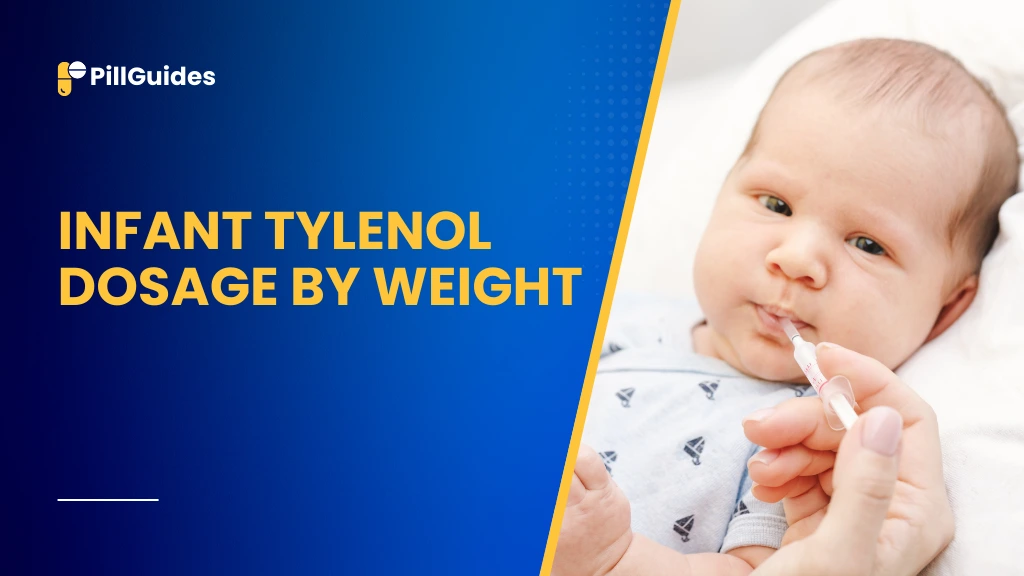Parenting a baby requires extensive health care management which brings both difficulty and stressful situations. The most frequently recommended medication for your child during fever or mild pain episodes is Infant Tylenol (acetaminophen). Correct weight-based administration of Infant Tylenol serves as a critical factor for both safety and medication effectiveness.
You should avoid administering an incorrect dose because lower amounts will be ineffective but higher amounts could lead to dangerous situations. This guide contains complete information about correct dosages alongside protection rules and answers to common questions to help users utilize Infant Tylenol effectively.
What is Infant Tylenol?
Infant Tylenol contains acetaminophen, which is widely used to reduce fever and relieve pain in infants and young children. Unlike ibuprofen (Motrin or Advil), which is another fever-reducing option, acetaminophen is generally recommended for younger babies because it is gentler on the stomach.
Why Choose Infant Tylenol?
- Safe for Infants: After the doctor’s advice, it can be given even to babies at the age of 2 months.
- Relief to Symptoms: They provide relief to symptoms of teething, colds, sore throats, ear infections, and vaccinations.
- It helps to reduce the Fever: In case of infection or vaccinations your baby’s temperature is high then this medicine will provide you relief.
- Less Likely to Give You Stomach Trouble: As with your stomach, acetaminophen is less likely to upset your stomach.
What is Infant Tylenol?
Most parents believe that age-based dosing is enough, weight based dosing is more accurate and successful. If your baby grows at different rates, weight provides the correct amount of medicine for his body size.
Why Choose Infant Tylenol?
Administering the wrong dosage can have consequences:
- Too Little: Might not effectively reduce fever or relieve pain.
- Too Much: Increases the risk of liver damage and toxicity.
This is why it is essential to follow a weight-based dosage chart and always use the correct measuring tools.
Infant Tylenol Dosage Chart by Weight
The chart below provides the recommended dosage based on weight. The standard concentration for Infant Tylenol is 160 mg/5 mL.
| Baby’s Weight (lbs) | Dosage (mL) |
| 6–11 lbs (2.7–5 kg) | 1.25 mL |
| 12–17 lbs (5.4–7.7 kg) | 2.5 mL |
| 18–23 lbs (8.2–10.4 kg) | 3.75 mL |
| 24–35 lbs (10.9–15.9 kg) | 5 mL |
Key Guidelines for Safe Dosage:
- Subsequently, dosage should only be used with the syringe or dropper provided to avoid inaccurate dosing.
- Do not exceed five doses in 24 hours.
- A minimum of 4–6 hours should pass before your next injection.
- The standard strength is 160 mg / 5 mL, check the medication label.
How to Administer Infant Tylenol Safely
To ensure proper infant pain relief, follow these step-by-step instructions:
1. Read the Label Carefully
Before giving any medication, check the concentration, expiration date, and dosage instructions.
2. Shake the Bottle Well
Tylenol is a suspension liquid, which means the ingredients can settle. Shake well before measuring the dose.
3. Use the Correct Measuring Tool
Always use the provided syringe or dropper rather than a household spoon to ensure accuracy.
4. Administer the Medicine Properly
- Place the syringe in your baby’s mouth (inside the cheek) to prevent choking.
- Administer the liquid slowly and in small amounts.
- If your baby spits out the medicine, do not immediately give another dose—wait for the next scheduled dose.
5. Monitor Your Baby’s Reaction
After giving Infant Tylenol, observe your baby for any adverse reactions, such as:
- Rash or hives
- Swelling of the face or tongue
- Difficulty breathing
- Persistent vomiting
If any of these occur, seek medical attention immediately.
Precautions and Safety Tips
- Never Mix Acetaminophen Drugs with Infant Tylenol because you should avoid combining it with any products containing acetaminophen including cold and flu medications.
- Consult your doctor before administering Tylenol to infants who require other prescribed medications.
- Note down every medicine dose your provider gives to avoid giving excessive quantities.
- It is important to both protect the medication from children and store Infant Tylenol in a dry location away from heat.
Conclusion
Infant Tylenol proves to be a secure medicine for treating both fever and pain symptoms in infants given proper dosage administration. Proper weight-based drug administration with correct measuring instruments along with safety precautions will guarantee your baby’s health.
The first step whenever giving medicine to your baby requires consultation with a pediatrician particularly when symptoms last beyond three days. Your baby’s safe recovery depends on both correct dose tracking along with following expert guidelines.
Disclaimer
This article is for informational purposes only and should not replace medical advice. Always consult a pediatrician before giving any medication to your child.
Tramadol vs Vicodin: Understanding the Key Differences
FAQs Infant Tylenol Dosage by Weight
1. Should I provide my child with Infant Tylenol together with ibuprofen?
Medically, alternating ibuprofen with acetaminophen for fever treatment is possible but seeks professional pediatrician approval first.
2. How many times per day can I provide Infant Tylenol to my child?
Infant Tylenol lets you take each dose every 4–6 hours but total doses should remain below five during a day.
3. What should I do if I provide an excessive amount of Tylenol?
In case you think an overdose occurred you must either contact Poison Control at (1-800-222-1222) or bring the patient to the closest emergency facility immediately.
4. Should I provide Infant Tylenol treatment to a newborn baby?
Parents should avoid giving Infant Tylenol to babies who are younger than 2 months old without a medical prescription.
5. How many hours does Infant Tylenol need to begin showing its effectiveness?
Infants will experience relief from symptoms after approximately thirty minutes and reach total effect after one to two hours from ingestion of Tylenol.










